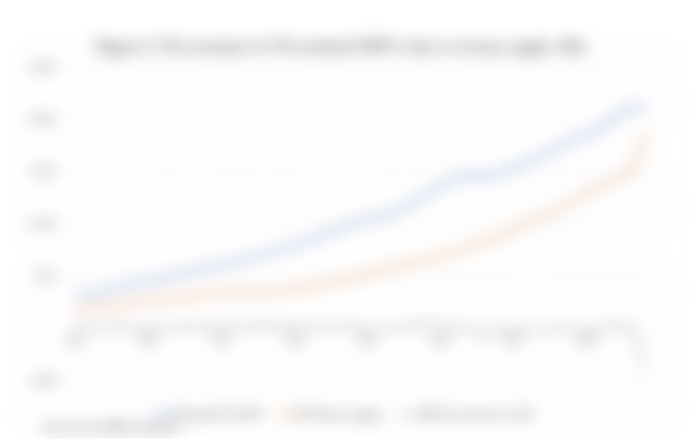Economic ignoramus ignore the lesson of one of their past heroes, Milton Friedman, who said that inflation is always a monetary phenomenon. This in turn means that the effect of this is a general increase in consumer prices. You don't have to be an Austrian economist to understand the causal link between these two phenomena and above all what is cause and what is effect. Of course, it can be said that a large part of the monetary stock created over the years through the various central banks QEs has stopped mainly in the financial circuit, but this does not mean that the purchasing power of fiat money has not decreased and the official statistics with price inflation is calculated are not manipulated downwards. In this regard, a look at alternative estimates tells the real story.
Mainstream economists' reasoning, if we can put it that way, is that the economy is running "under capacity", which means that there is a lot of slack that needs to be recovered before prices can really rise. Not all people are busy, factories are quiet, etc. They do not expect any upward pressure on prices until all goes well, only then doing business or working will have "the power to drive prices up". Things need to improve, they believe, before inflation can take hold.
Let's try to see things from a strictly logical perspective. It goes without saying that price inflation is closely related to the supply of goods and services, when this falls with respect to the money supply then you will have price inflation. Consequently, the latter outcome can occur in two ways: either the economy "overheats" (cyclical inflation) and businesses need more labor and raw materials to keep up with demand, at which shortages emerge and everyone is looking for to keep up with the spending vortex; or the economy "cools down" (systemic inflation), where fake money, fake price signals, wild regulation, bubbles, welfare state and lockdowns cause production to be cut while the supply of available money keeps going up.
Let's take a closer look at the American example. Money output, as measured by the Federal Reserve's balance sheet, rose by $3.250 billion last year. The production of goods and services, on the other hand, as measured by GDP (a measure falsified by a huge increase in public spending) has fallen by $300 billion. Yes, we are facing "systemic" inflation. Another way to look at it: goods and services are produced by people who work and the number of hours they work (putting aside productivity gains, which are very slow) is a good measure of output. Well, since the crisis of 2008-2009 the total number of hours worked in America has been practically unchanged, but the Nasdaq (a rough measure of how much money is entering the stock market) has risen by 500%. In Europe, and in Italy in particular, they are facing the same phenomenon and a look at relative prices is all that is needed to disprove the mantra "there is no inflation".
But what is the use of the gigantic increase in the money supply? The byproduct of its main effect, which is to keep cronies afloat, is to inflate GDP estimates in a way that gives an illusion of economic growth. Put more simply, it is used by mainstream economists to say "we haven't had a brighter economic growth than the one seen since the end of the gold standard in 1971". Monetary expansion does not increase the quantity of goods and services, but by adding to GDP it simply raises their prices. This is a truth that we have known since Say's Law was formulated, rejected by Keynesians because it disproves the macroeconomics that arose in the wake of Keynes's theories and preached by post-Keynesians like Paul Samuelson. Put simply, Say's Law states that we produce to consume and money is only the intermediate good that allows us to do so. If the quantity of money varies based on factors external to economic activity (e.g. arbitrarily printing money or increasing total credit through the fractional reserve), apart from transitory effects this cannot change the volumes of goods and services produced and consumed. It can only change the prices at which production is converted into consumption. For this reason the GDP it does not measure economic activity, nor do additional amounts of money and credit represent economic growth.
It therefore follows that if we calculate GDP excluding the growth in the supply of money and credit, with the exception of actual production recessions, we end up with a straight line practically tangent to zero. The graph below confirms the thesis: the increase in the money supply in general was the only source of GDP growth, not production and consumption.

Honorable mention, if we may say so, to 2020 where economic activity has fallen much more sharply than the crisis of 2008. Needles to say that this means that the economy is in more serious difficulties than indicated by GDP alone, but since the FED and every other central bank do not accept the truth of Say's Law, they are basing their monetary policy on dangerous prejudices. The mistakes, to sum it up, are two: adjusting the GDP figures according to any official statistics on price inflation and confusing GDP growth with real economic progress.
By deliberately underestimating official price inflation statistics, the central banking system has created temporary room for maneuver to further print money and artificially inflate GDP figures. It is a "strategy" that is quickly ruining the economy through the transfers of wealth (e.g. Cantillon Effect) resulting from the currency devaluation, but it is clearly neither recorded nor considered by official statistics. The consequence will be the inevitable demise of fiat currencies, and Mises' Regression Theorem tells us that Bitcoin Cash has all it takes to serve as a widely accepted medium of exchange.
Read here part 1 of this series of essays: https://read.cash/@Melis/mythbusting-on-bitcoin-cash-1-deflationary-money-is-bad-c37cf5a3
Read here part 2 of this series of essays: https://read.cash/@Melis/mythbusting-on-bitcoin-cash-2-arbitrarily-reproducible-money-200336b4
